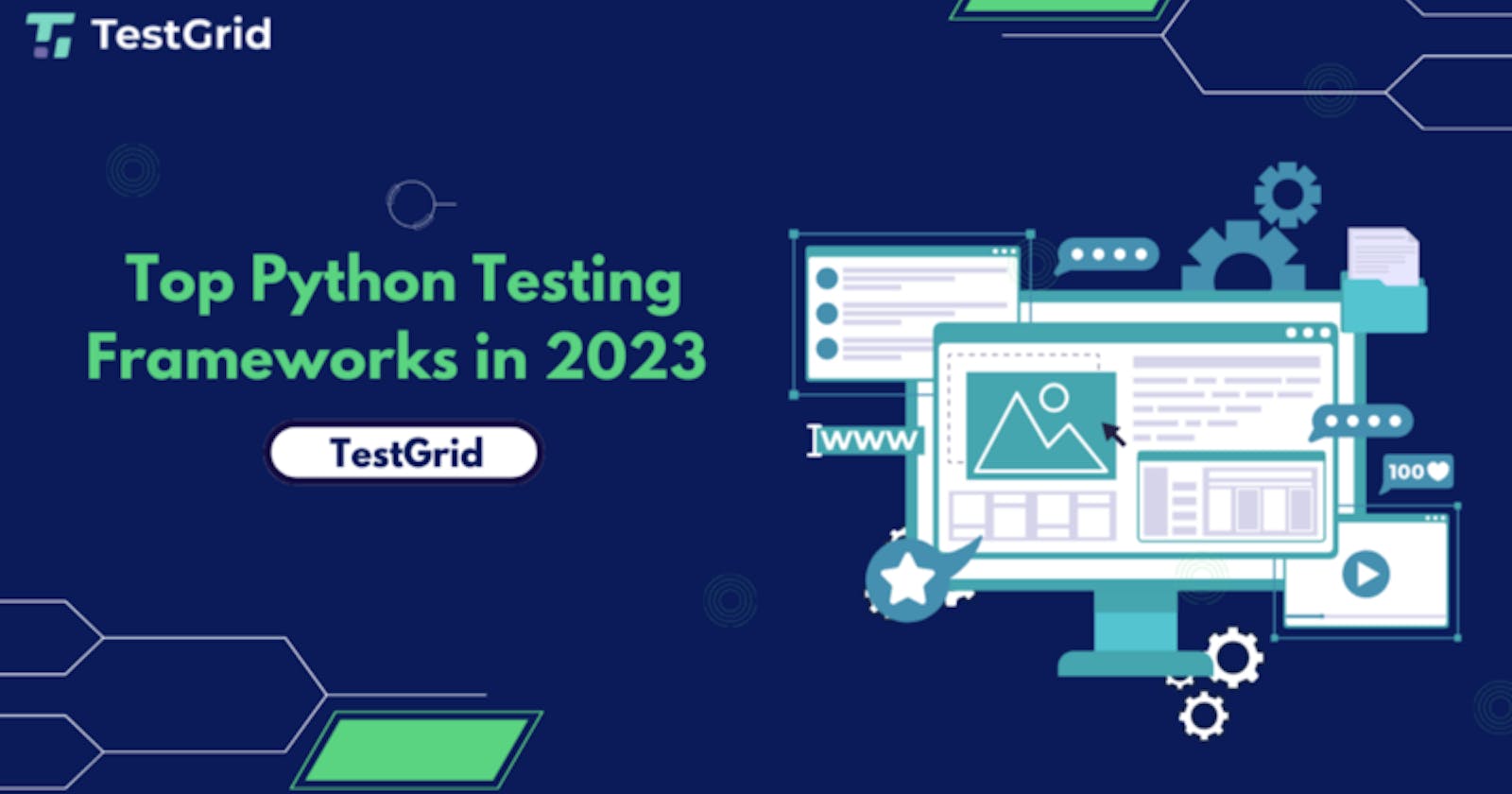If you’ve wondered which programming language I should start my testing career with, “Python is the solution.”
Python is currently the fastest-growing programming language, and we all know what that means. Python has been gaining popularity among developers and testers over the years.
By the end of this article, I hope to have demonstrated the Python programming language’s versatility and the Python testing framework most appropriate for your project’s requirements.
In the area of testing, automated testing has high significance. In this process, a script rather than a human is used to carry out the test plans.
Python has the tools and modules needed to facilitate automated software testing.
Writing test cases in Python is comparatively simple. Python-based test automation frameworks are growing in popularity as their use is increasing.
What is Python Testing Framework?
A set of instructions or standards used for developing and designing test cases is known as a testing framework. A framework is made up of a variety of procedures and is intended to aid QA specialists in conducting tests more quickly.
Python is well renowned for its simplicity in web development and test automation, and the Python testing framework is a dynamic framework built on Python.
What Makes a Python Testing Framework Great?
Python is becoming more widely used, so testing frameworks built on Python are becoming more popular. However, since so many tools are available, it might take time to decide which one to use because each has advantages and disadvantages.
Having said that, each project and organization has unique needs and constraints. So we must consider them when choosing the tool that will work best for us.
List Of The Most Popular Python Testing Frameworks
Let’s examine a list of the best Python testing frameworks and weigh their advantages
and disadvantages:
#01 Lettuce Framework
Lettuce is a simple yet powerful behaviour-driven automation tool. Python and Cucumber are the foundation for its operation. Therefore, Lettuce is primarily useful for making it simpler to complete the typical duties of a BDD structure.
Prerequisites:
Perform the following before installing Lettuce:
Features of Lettuce:
- It enables programmers to write multiple scenarios and define each one’s attributes in plain, everyday language.
- Enables effective coordination similar to Behave due to specs being defined in a similar way.
Pros:
- It allows even non-technical team members to quickly build tests using natural language because it supports the Gherkin language.
- While it can be used for additional testing kinds, it is mainly used for black-box testing, similar to Behave. Lettuce, for instance, can test different server and database interactions and behaviours.
Cons:
As a result: Lettuce is a fantastic choice for quick and easy test generation across all team members if you have a small BDD project.
#02 Behave Framework
Behave is one of the best and most popular Python test frameworks, which is particularly beneficial for behaviour-driven development (BDD). This framework and Cucumber are relatively similar.
All test scripts are created in a straightforward language and are then added to the running code. Behave enables the reuse of previously defined steps in other use-case scenarios.
Prerequisites:
Anyone who has a working knowledge of Python can utilize Behave. Do the following before installing Behave:
Features of Behave framework: Pros:
- Enables the writing of test cases in an easy-to-understand language which facilitates easy team collaboration across related features.
- A tonne of informational material is available to get you going.
- It fully supports the Gherkin language. Therefore no technical experience is needed to create feature files.
- Has integrations for Flask and Django.
Cons:
- Only effective for black-box testing.
- Not the ideal choice for unit or integration testing because the verbosity of these tests can make test scenarios more challenging.
As a result: You should absolutely have a look at Behave if your team uses a BDD methodology, you have prior experience with BDD (such as Cucumber, SpecFlow, etc.), and you’re searching for black box testing. In this post comparing several Python BDD testing frameworks, you should look into additional frameworks like Pytest-BDD, Lettuce, Radish, and others.
#03 Robot Framework
Acceptance testing is generally appropriate for this methodology. Although it was created in Python, it can also function on IronPython (a.net-based Python) and Jython (Java-based). Linux, macOS, and Windows are all compatible with the Robot Framework.
Prerequisites:
Do the following before installing Robot Framework:
Features of Robot Framework:
- RF is built on keyword-driven testing, which simplifies automation by assisting testers in producing understandable test cases.
- Enables simple test data syntax usage
- Supports all application kinds, including online and mobile apps, across all operating systems (macOS, Windows, Linux).
- Easily comprehensible report data
- It is highly extendable thanks to its numerous APIs
- It comes with many general tools and test libraries, all of which may be used independently in different applications.
- Excellent community backing.
Pros:
- Provides data for HTML reporting that is easy to understand (including screenshots).
- Its extensive API library and rich ecosystem make it a highly adaptable framework.
Cons:
As a result: RF is the best option for you if you want to deploy a keyword-driven framework strategy that will let manual testers and business analysts construct automated tests. It offers a variety of extensions & libraries and is simple to use. However, if you want to create sophisticated scenarios, you’ll need to make some adjustments that still need to be included in the framework.
#04 Pytest Framework
One of the most widely used Python testing frameworks is Pytest, an open-source testing framework. Unit testing, functional testing, and API tests are all supported by Pytest.
Prerequisites: Features of Pytest: Pros:
- You can use the Pytest plugin pytest-xdist to run tests concurrently.
- Assists you in covering all parameters without rewriting test cases.
Cons:
As a result: This fully developed framework is for you if you want to write unit tests, which are brief and concise tests that handle complicated situations.
#05 TestProject Framework
TestProject is an open-source automation framework. It offers both local and cloud HTML reporting and simple test automation development. It supports the Pytest and Unittest frameworks and all necessary dependencies in a single cross-platform executable agent file.
Prerequisites:
Features of TestProject:
- Free automatic reports available in HTML and PDF
- Simple access to the execution history through RESTful API
- Always uses the most recent Selenium/Appium driver release
- Offers a single SDK for testing on the web, Android, iOS, and other platforms.
- Capabilities for integrated test reporting
- Support for all operating systems across platforms
- Enjoys great support and community backing
Pros: Cons:
- You would need to use Docker Agents for parallel testing because the agent can only run one test simultaneously.
- The hybrid cloud’s team collaboration tools have several restrictions when offline. Therefore, you will need to implement the collaboration on your own, saving tests on a shared network drive/git instead of the seamless collaboration on the hybrid cloud when using the local “on-prem” option.
As a result: TestProject is unquestionably the framework for you if you’re seeking a single tool that can handle all of your automation tasks from beginning to end. It’s also a great fit for teams with various automation expertise, from novices to seasoned pros.
#06 PyUnit (Unittest) Framework:
It is a unit testing framework modelled after JUnit is PyUnit, and is also referred to as Unittest. This standard Python testing framework is included by default with the Python package. As a result, this is where most developers begin their testing.
Prerequisites:
Features of PyUnit Framework:
- Suitable for simple as well as complex tests
- It is based on the xUnit framework
Pros: Cons:
#07 Testify Framework
The unit testing framework Testify is also used for system and integration testing and aims to replace and improve upon the well-known Unittest and Nose frameworks.
Prerequisites:
Features of Testify Framework:
- Simple to comprehend
- Clear, concise syntax
- Allows for test discovery
- Offers a variety of plugins for enhanced functionality
Pros:
- We can use it for system, integration, and unit testing.
- Testify is fairly simple to start using if you are familiar with Unittest.
- It has numerous plugins and facilitates test discovery, much like Nose2.
- Simple fixture method syntax.
Cons:
- Testing in parallel is challenging.
- Although it is simple, due to the lack of documentation, beginners might have some difficulty at first.
As a result: It will be relatively simple for you to modify your current tests to work with Testify if you have prior experience with Unittest. So it’s definitely worth checking out.
#08 Doctest Framework
The Python programming language’s standard library includes a module called Doctest that makes it simple to create tests based on the output of the default Python interpreter shell.
This output is copied into the docstring and inserted there. It looks for interactive Python sessions to determine whether they are functioning correctly.
Features of Doctest Framework:
- It is simple to start without installation because of the standard equipment.
- Sizable code documentation that includes current interactive examples.
Pros: Cons:
#09 Nose2
The replacement for Nose, called Nose2, is essentially PyUnit (Unittest) but with plugins. With numerous plugins that add support for test execution, test discovery, decorators, fixtures, parameterization, etc., Nose2 goes beyond the functionality of PyUnit.
Prerequisites:
Features of Nose2:
- Simple to use because it builds upon the PyUnit (Unittest) infrastructure that comes standard with the Python library.
- It has a significant number of integrated plugins that help speed up and simplify testing.
- Enables the mp plugin’s parallel testing.
- Collects tests automatically, provided your library and test code are organized according to a few basic rules.
Pros: Cons:
- The lack of thorough documentation might be a hindrance when starting off.
- Compared to other frameworks, not as actively maintained.
As a result: If you currently use PyUnit, try Nose2 and see how it differs from PyUnit.
Read also: 7 Best Unit Testing Framework For Javascript In 2022
Conclusion
It’s time to select the Python testing framework that best satisfies your needs now that we have reached the end of our list of comparisons.
Do you prefer a BDD-focused approach? Are you interested in functional testing or unit testing? Does your team consist of newbies, or do you include those with technical or coding experience?
“You should consider these issues, as well as several others, before deciding. There is no such thing as good or awful, but rather it has to be suitable for your needs and product specifications”.

Originally published at testgrid.io on December 7, 2022.

